Java第八次作业
//1、编写一个简单程序,要求数组长度为5,分别赋值10,20,30,40,50,在控制台输出该数组的值。(知识点:数组定义和创建、一维数组初始化)[必做题]?
public class Test1 {
/**
* @param args
*/
public static void main(String[] args) {
// TODO Auto-generated method stub
int a[]={10,20,30,40,50};
for (int i : a) {
System.out.println(i);
}
}
}
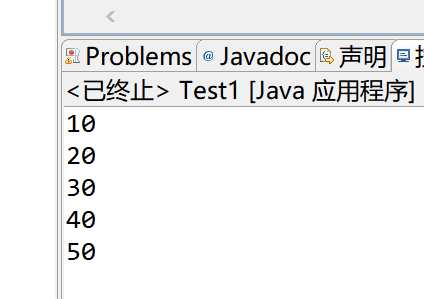
//2、将一个字符数组的值(neusofteducation)拷贝到另一个字符数组中。(知识点:数组复制) [必做题]?
public class Test2 {
/**
* @param args
*/
public static void main(String[] args) {
// TODO Auto-generated method stub
int a[] = { 1, 2, 3, 4, 5 };
int b[] = new int[a.length];
System.arraycopy(a, 0, b, 0, a.length);
for (int i : b) {
System.out.println(i);
}
}
}
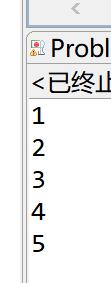
//3、给定一个有9个整数(1,6,2,3,9,4,5,7,8)的数组,先排序,然后输出排序后的数组的值。(知识点:Arrays.sort排序、冒泡排序)
public class Test3 {
/**
* @param args
*/
public static void main(String[] args) {
// TODO Auto-generated method stub
int a[] = { 1, 6, 2, 3, 9, 4, 5, 7, 8 };
for (int i = 0; i < a.length - 1; i++) {
for (int j = 0; j < a.length - 1 - i; j++) {
if (a[j] > a[j + 1]) {
int b = 0;
b = a[j];
a[j] = a[j + 1];
a[j + 1] = b;
}
}
}
for (int i : a) {
System.out.println(i);
}
}
}
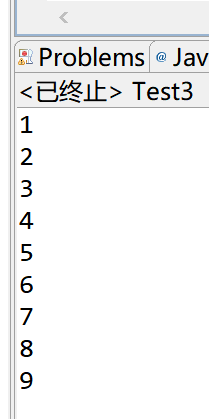
//3、给定一个有9个整数(1,6,2,3,9,4,5,7,8)的数组,先排序,然后输出排序后的数组的值。(知识点:Arrays.sort排序、冒泡排序)
import java.util.Arrays;
public class Test4 {
/**
* @param args
*/
public static void main(String[] args) {
// TODO Auto-generated method stub
int a[] = { 1, 6, 2, 3, 9, 4, 5, 7, 8 };
Arrays.sort(a);
for (int i : a) {
System.out.println(i);
}
}
}
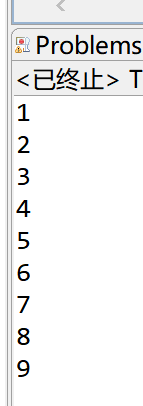
//3、给定一个有9个整数(1,6,2,3,9,4,5,7,8)的数组,先排序,然后输出排序后的数组的值。(知识点:Arrays.sort排序、冒泡排序)
import java.util.Arrays;
public class Test4 {
/**
* @param args
*/
public static void main(String[] args) {
// TODO Auto-generated method stub
int a[] = { 1, 6, 2, 3, 9, 4, 5, 7, 8 };
Arrays.sort(a);
for (int i : a) {
System.out.println(i);
}
}
}

//4、 输出一个double型二维数组(长度分别为5、4,值自己设定)的值。(知识点:数组定义和创建、多维数组初始化、数组遍历)
public class Test5 {
/**
* @param args
*/
public static void main(String[] args) {
// TODO Auto-generated method stub
double a[][] = new double[5][4];
for (int i = 0; i < a.length; i++) {
for (int j = 0; j < a[i].length; j++) {
a[i][j] = j;
System.out.print(a[i][j] + " ");
}
System.out.println();
}
}
}
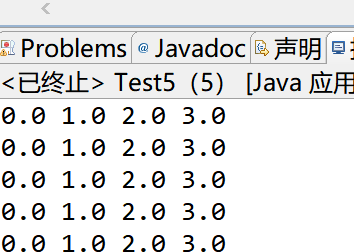
//5、 在一个有8个整数(18,25,7,36,13,2,89,63)的数组中找出其中最大的数及其下标。(知识点:数组遍历、数组元素访问) [必做题]?
public class Test6 {
/**
* @param args
*/
public static void main(String[] args) {
// TODO Auto-generated method stub
int a[] = { 18, 25, 7, 36, 13, 2, 89, 63 };
int max = 0;
for (int i = 0; i < a.length; i++) {
if (i == 0) {
max = a[0];
}
if (a[i] > max) {
max = a[i];
}
}
System.out.println("最大值为" + max);
}
}
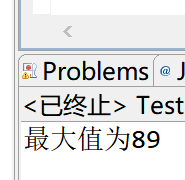
//6、将一个数组中的元素逆序存放(知识点:数组遍历、数组元素访问)
public class Test7 {
/**
* @param args
*/
public static void main(String[] args) {
// TODO Auto-generated method stub
int a[] = { 1, 2, 3, 4, 5 };
int b = 0;
for (int i = 0; i < a.length / 2; i++) {
b = a[i];
a[i] = a[a.length - 1 - i];
a[a.length - 1 - i] = b;
}
for (int i : a) {
System.out.println(i);
}
}
}
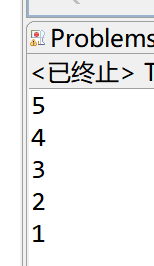
//7. 将一个数组中的重复元素保留一个其他的清零。(知识点:数组遍历、数组元素访问)
public class Test8 {
/**
* @param args
*/
public static void main(String[] args) {
// TODO Auto-generated method stub
int a[] = { 1, 2, 3, 4, 5, 6, 7, 8, 1, 2 };
for (int i = 0; i < a.length; i++) {
for (int j = i + 1; j < a.length; j++) {
if (a[i] == a[j])
a[j] = 0;
}
}
for (int i : a) {
System.out.println(i);
}
}
}
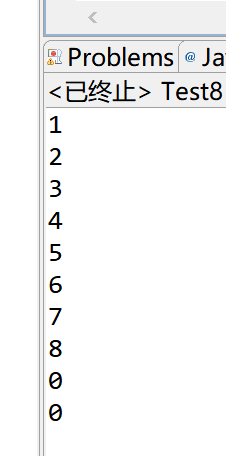
//8、给定一维数组{ -10,2,3,246,-100,0,5},计算出数组中的平均值、最大值、最小值。(知识点:数组遍历、数组元素访问)
public class Test9 {
/**
* @param args
*/
public static void main(String[] args) {
// TODO Auto-generated method stub
int a[] = { -10, 2, 3, 246, -100, 0, 5 };
double p = 0;
int sum = 0;
int max = 0;
int min = 0;
for (int i = 0; i < a.length; i++) {
if (i == 0) {
max = a[0];
min = a[0];
}
if (max < a[i])
max = a[i];
if (min > a[i])
min = a[i];
sum = sum + a[i];
}
p = sum / a.length;
System.out.println("平均值为" + p + " 最大值为" + max + " 最小值为" + min);
}
}

//9、使用数组存放裴波那契数列的前20项 ,并输出
public class Test10 {
/**
* @param args
*/
public static void main(String[] args) {
// TODO Auto-generated method stub
int a[] = new int[20];
a[0] = 1;
a[1] = 1;
for (int i = 2; i < a.length; i++) {
a[i] = a[i - 1] + a[i - 2];
}
for (int i : a) {
System.out.println(i);
}
}
}

//10、生成一个长度为10的随机整数数组(每个数都是0-100之间),输出,排序后,再输出
import java.util.Random;
public class Test11 {
/**
* @param args
*/
public static void main(String[] args) {
// TODO Auto-generated method stub
Random r = new Random();
int a[] = new int[10];
for (int i = 0; i < a.length; i++) {
a[i] = r.nextInt(100);
}
for (int i : a) {
System.out.print(i + ",");
}
System.out.println();
for (int j = 0; j < a.length - 1; j++) {
for (int k = 0; k < a.length - 1 - j; k++) {
if (a[k] > a[k + 1]) {
int m = a[k];
a[k] = a[k + 1];
a[k + 1] = m;
}
}
}
for (int i : a) {
System.out.print(i + ",");
}
}
}



